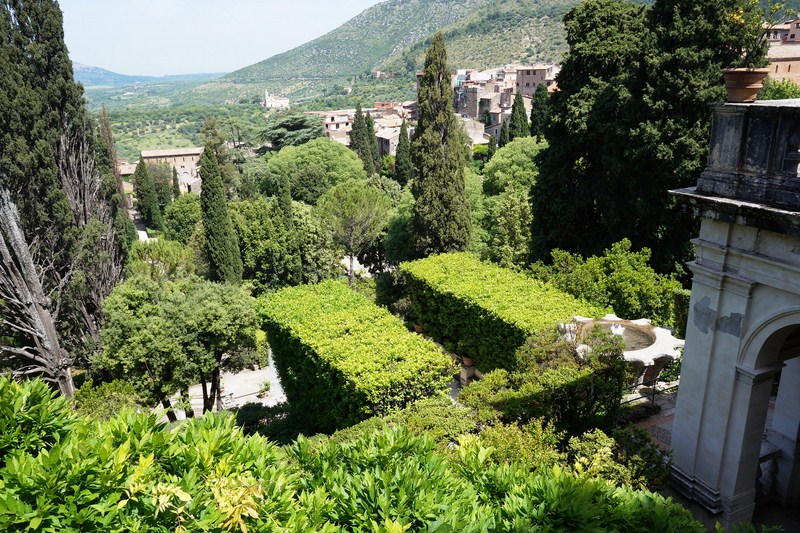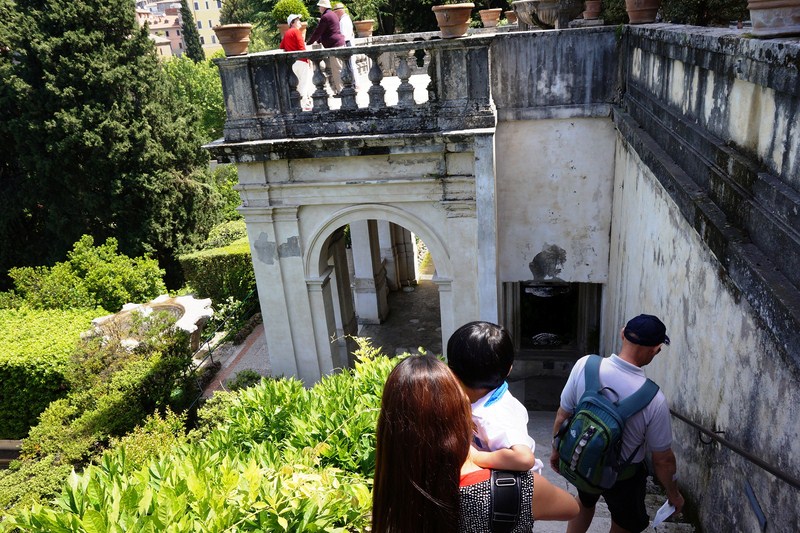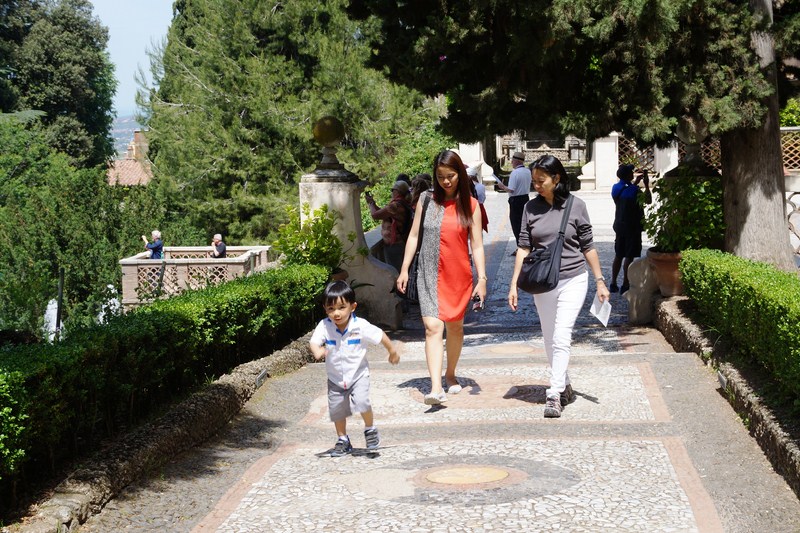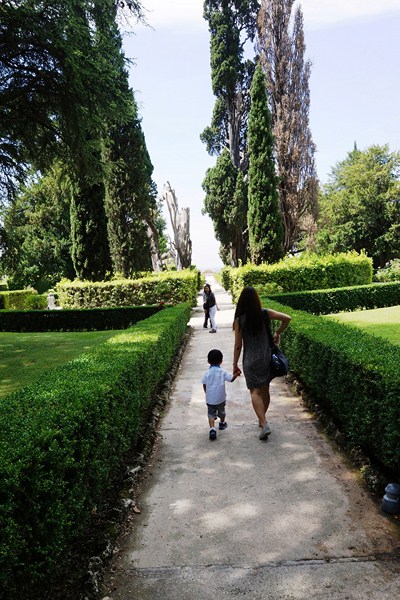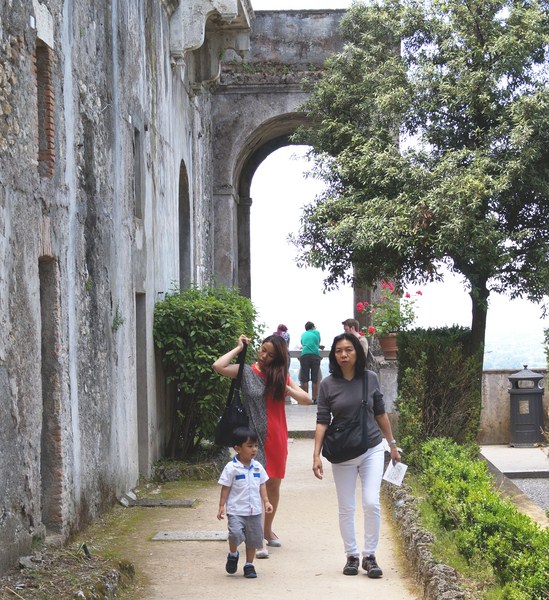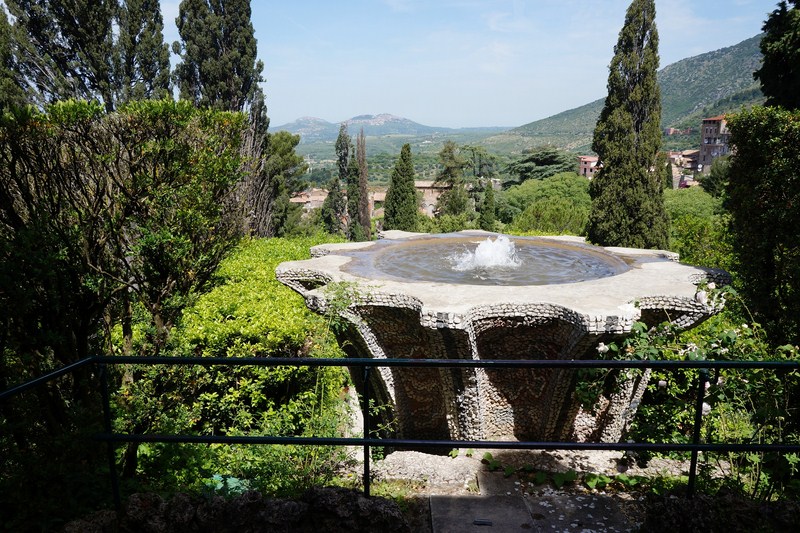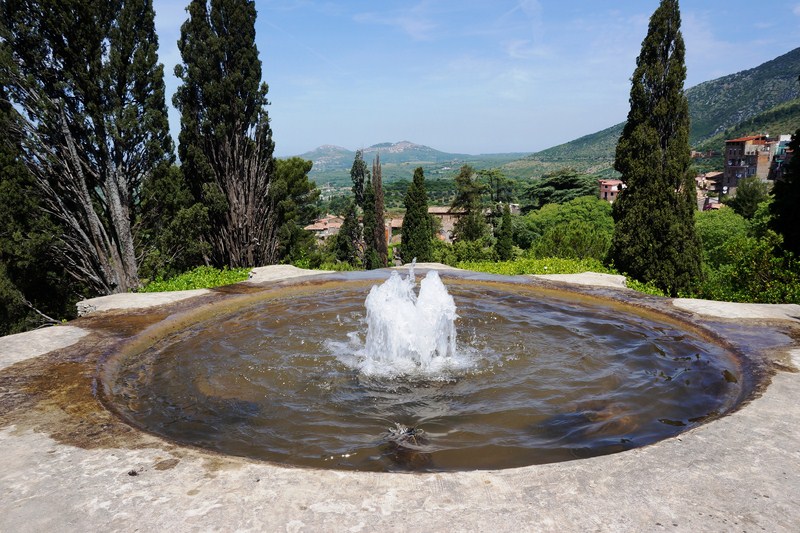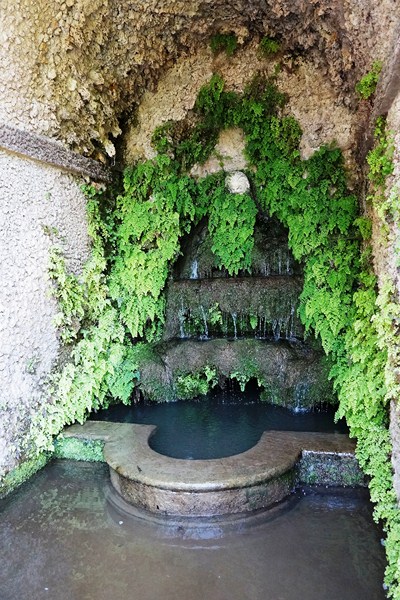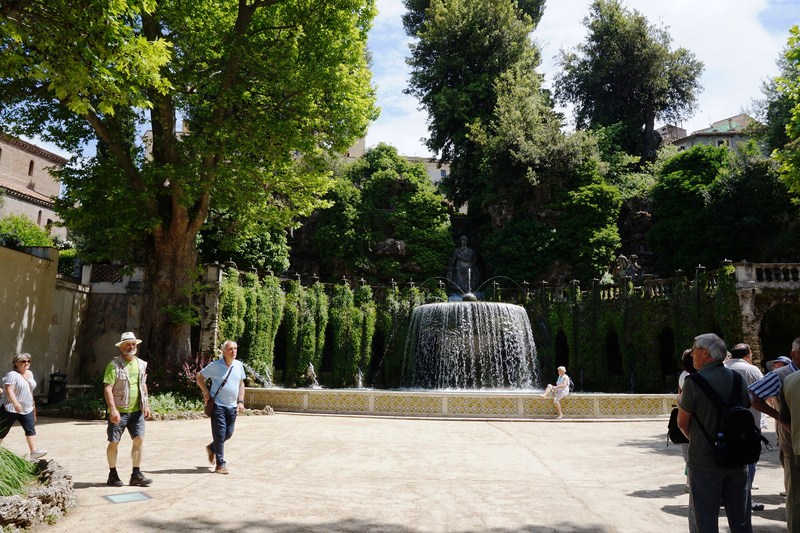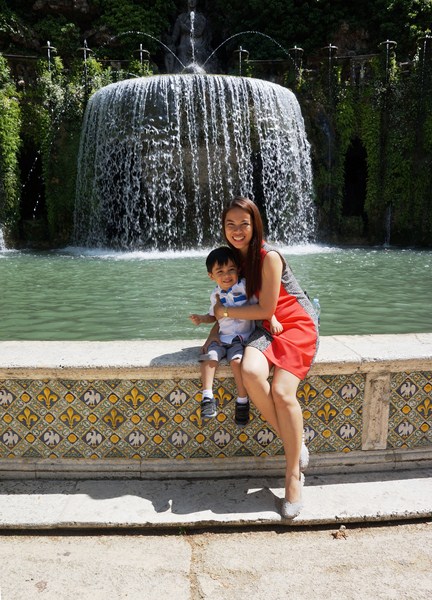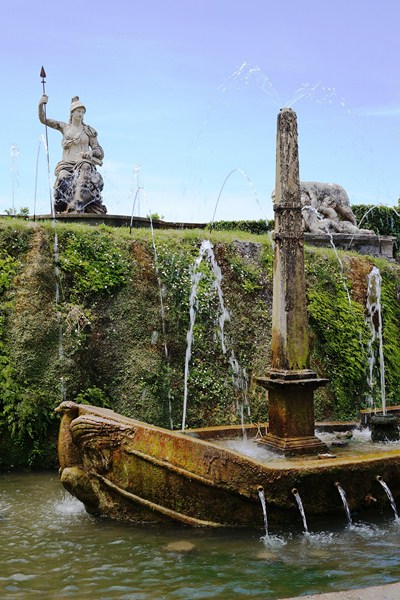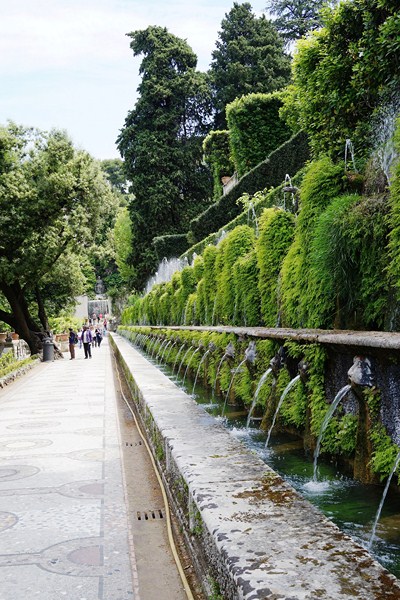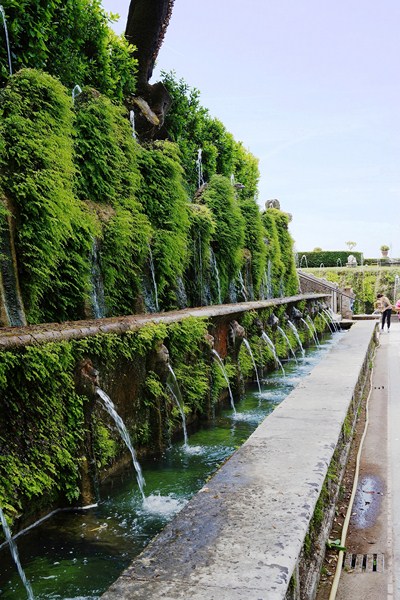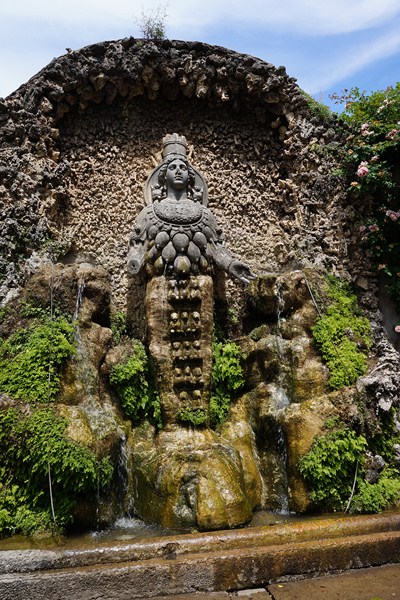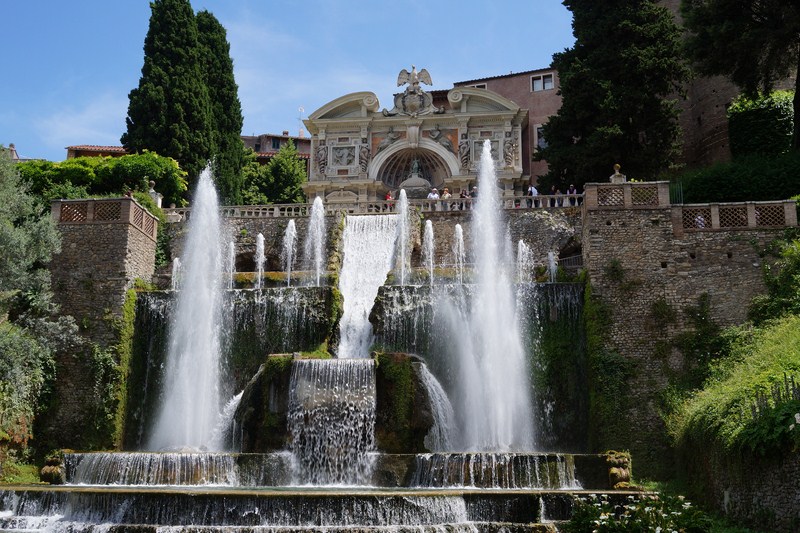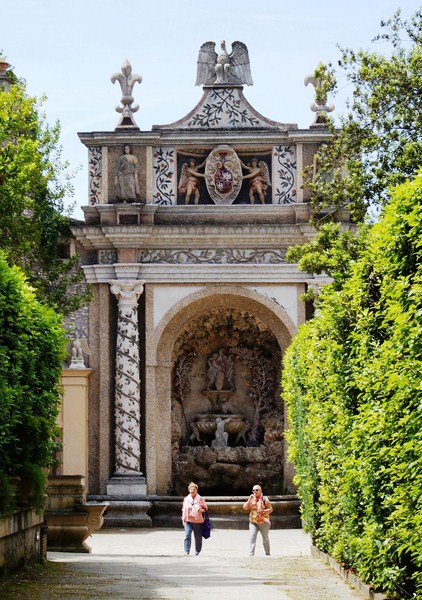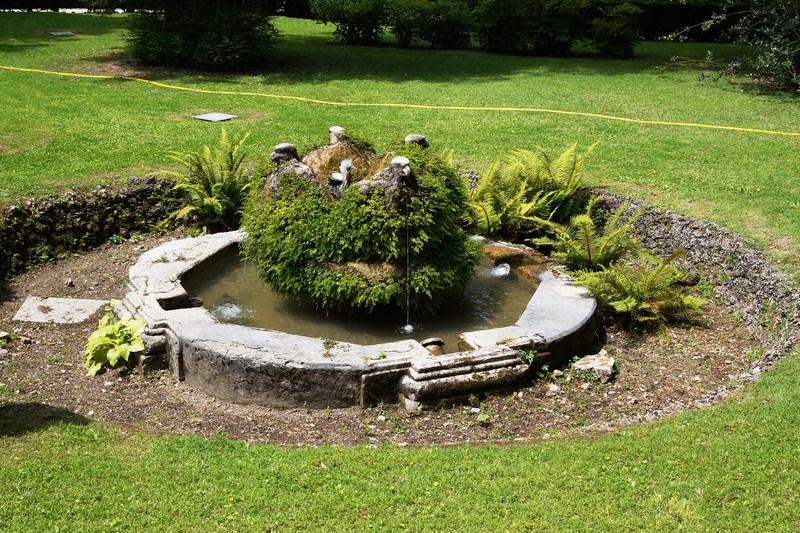The palatial setting of Villa d’Este is surrounded by a spectacular terraced garden, in the late-Renaissance Mannerist and Baroque style, which took advantage of the dramatic slope but required innovations in bringing a sufficient water supply, which was employed in cascades, water tanks, troughs and pools, water jets and impressive concentration of fountains, water games. This masterpiece of the Italian Garden is included in the UNESCO world heritage list.
Reviving Roman techniques of hydraulic engineering to supply water to a sequence of fountains, the cardinal created a fantasy garden whose architectural elements and water features had an enormous influence on European landscape design and their garden planning and water features such as fountains, nymphs, grottoes, plays of water and music were much copied in the next two centuries, in European gardens from Portugal to Poland to St. Petersburg. The result is one of the series of great 17th century villas with water-play structures in the hills surrounding the Roman Campagna, such as the Villas Aldobrandini and Torlonia in Frascati; the Villa Lante and the Villa Farnese at Caprarola.
- Painter, architect, archaeologist and Classical scholar Pirro Ligorio was commissioned to lay out the gardens for the villa, with the assistance of Tommaso Chiruchi (he had worked on the fountains at Villa Lante) of Bologna, one of the most skilled hydraulic engineers of the sixteenth century. In the technical designs for the fountains, Chiruchi was assisted by Claude Venard, a Frenchman who was a manufacturer of hydraulic organs.
- From 1605 Cardinal Alessandro d’Estegave the go-ahead to a new progam of interventions. He restored and repaired the vegetation and the waterworks and created a new series of innovations to the layout of the garden and the decorations of the fountains.
- From 1660 – 61, works on 2 fountains were carried out involving Gian Lorenzo Bernini.
- In the eighteenth century the villa and its gardens passed to the House of Habsburg after Ercole III d’Este bequeathed it to his daughter Maria Beatrice, married to Grand Duke Ferdinand of Habsburg. The gardens were slowly abandoned and The hydraulics fell into disuse and ruin, and many of the collection of ancient sculptures, enlarged under Cardinal Ippolito d’Este, were disassembled and scattered to other sites. This picturesque state of decay continued, without interruption, until the middle of the 19th century. It was recorded by Carl Blechen and other painters.
- In 1851, Cardinal Gustav von Hohelohe, Prince of Hohenlohe-Schillingfürst, obtained the villa, in enfiteusi, from the Dukes of Modena. To pull the complex back from its state of ruin, he launched a series of works. Between 1867 and 1882, the villa once again became a cultural point of reference.
The garden has been celebrated in poetry, painting and music:
- The musician Franz Liszt (1811 – 1886), who evoked the garden in his Les Jeux d’Eaux à la Villa d’Este and composed Giochi d’acqua a Villa d’Este for piano while a guest here, gave one of his last concerts here in 1879.
- Jean Garrigue‘s volume of poems A Water Walk by Villa d’Este (1959) continues a long tradition of poetry inspired by the gardens.
- Kenneth Anger filmed Eaux d’artifice among the water features of the garden.
Villa d’Este’s fame and glory as one of the finest gardens of the Renaissance was established by its extraordinary system of fountains. It has 51 fountains and nymphaeums, 398 spouts, 364 water jets, 64 waterfalls and 220 basins, all fed by 875 m. of canals, channels and cascades, and all working entirely by the force of gravity, without pumps.
The gardens, now part of the Grandi Giardini Italiani, fall away in a series of terraces. The garden plan is laid out on a central axis with subsidiary cross-axes, refreshed by some 500 jets in fountains, pools and water troughs. Originally supplied with water by the Rivellese spring (which supplied a cistern under the villa’s courtyard), it is now supplied with water by the nearby Aniene River, which is partly diverted through the town, a distance of a kilometer.
The Vialone, a large, 200 m. long terrace that lies between the villa and the gardens, was constructed between 1568 and 1569. It has a panoramic view of the gardens and countryside beyond and the Cardinals used the space for fireworks, games, spectacles and festivities. Originally shaded by two rows of elm trees (except for the space directly in front of the villa, left empty to preserve the view), the terrace is enclosed at one end by the Fountain of Europa and, at the other, by the Cenacolo, an immense loggia and belvedere, in the form of a triumphal arch, that provided shade beneath in summer, as well as commanding viewpoints of the scenery. Its interior, originally intended to be decorated with stucco decoration, gilding and frescoes, was never finished.
The double loggia in the center of the terrace, made with travertine stone from 1566–1577, is attached to the facade of the villa. Two stairways provide access to the ceremonial salons on the lower floor. Its upper level, created as a terrace for the Cardinal’s apartments, contains a Nymphaeum (grotto) where the Fountain of Leda is located. The original statuary of the fountain, depicting Jupiter and Leda transformed into a swan and four children (Elena, Clytemnestra, Castor and Pollux), was sold in the 18th century and is now in the Galleria Borghese in Rome. The original fountain featured a novel hydraulic trick – water spouting from a vase held by Leda struck a metal disk, causing flashes of light to reflect on the walls of the grotto. The statuary has been replaced by headless statue of Minerva, found in the garden of the Palazzo Manni in Tivoli.
The Fountain of the Tripod, a copy (the original is now in the Louvre) of an ancient Roman fountain in the center of the Vialone, has only been there since 1930. It consists of a marble basin supported by a central column and three pilasters. The Fountain of the Sea Horses, the original fountain on the site, was moved, by Ippolito, from Hadrian’s Villa to his garden. It is now in the Vatican Museum.
The Fountain of Europa, at the northeast end at the top of the garden, was begun by Ippolito but was not finished until 1671. Its design, copying that of the Grand Loggia, consists of a triumphal arch with two orders (Corinthian and Doric) of columns. The large empty niche in the center once held a sculpture Europa Embracing the Bull which is now in the VIlla Albani in Rome.
From Fountain of the Tripod, two ramps lead down to the upper garden and, at either end, there are symmetrical double flights of stairs. The shaded Cardinal’s Walk, attached to the retaining wall of the terrace, leads from one side of the garden to the other, passing by several grottos which are built into the retaining wall. The Grotto of Igea and Aesculpius, at the southeast end of the walk, just below the Fountain of Europa, is decorated with tartar flakes, mosaics and colored fragments of sea shells, and a small portion of the original fresco. It originally held two statues. The statue of Aesculpius, the God of Medicine, is now found in the Louvre while that of Igea, the daughter of Auesculpius and the Goddess of Healing, is now in the Vatican Museum.
The Loggia of Pandora, in the middle of the Cardinal’s Walk, just below the center of the Villa, is covered, with arcades looking out at the garden. It contains a nymphaeum built into the wall and, originally, was decorated with mosaics and with two statues of Minerva and a statue of Pandora carrying a vase (actually a concealed fountain pouring out water) of water (symbolizing the evils of the world). The statues were sold in the 18th century. The staue of Pandora and one of the Minervas are now in the Capitoline Museum. In the 19th century, the nymphaeum was converted into a Christian chapel, a favorite place of the composer Franz Liszt, who dedicated two pieces of music to the chapel.
The Fountain of the Bicchierone, one of two fountains created for the villa by Gian Lorenzo Bernini, was made between 1660 and 1661 on a commission from Cardinal Rinaldo I d’Este. The basin of the fountain, in the form of a large shell which reaches up to the level of the terrace, has a toothed Bicchierone (cup or chalice) in the center, from which water sprays upwards. Bernini supervised the building of the fountain and, following its inauguration in May 1661, had the height of the spouting water reduced, to avoid blocking the view from the Loggia of Pandora. Though not part of the original design of the garden, the fountain became a link between the architecture of the palace and the garden.
The Loggetta of the Cardinal, a small ballustraded terrace between the Fountain of the Biccherone and the garden, was said to be the Cardinal’s favorite spot for reading and discussing poetry and art, and watching the construction of the garden around him. Surrounded by high laurel hedges and stone benches, it originally had a large statue (now found in the Louvre), installed shortly after the Cardinal’s death, of Hercules with the boy Achilles in his arms, overlooking the garden below. It was one of three statues of Hercules, in central positions along the central axis, that were all visible when seen from the bottom the garden, aligned with the loggia of the villa at the top.
The Grotto of Diana, at the end of the Cardinal’s Walk, below the Gran Loggia, is a large underground vaulted chamber decorated from 1570-72 by Paolo Caladrino. It is completely covered with mosaics of mythological scenes, with images of fish, dragons, dolphins, pelicans and other animals, as well as the eagles and apples of the d’Este family. The rustic fountain, its central feature, has a statue of the goddess Diana in a large niche decorated with stucco reliefs of landscapes, the sea and a ship. Sold in the 18th century, all of these statues are now in the Capitoline Museum in Rome. Some of the original 16th century majolica floor tiles can still be seen.
A walkway, below the Loggetta of the Cardinal, traverses the garden and passes by three grottoes. The Grotto of Hercules, in the center, is covered by the Loggetta of the Cardinal. Beneath it is a cistern and some of the hydraulic machinery for the fountains below. The grotto once had stucco reliefs of either animals or the labors of Hercules and a statue of Hercules in repose (now in the Vatican Museum).
The Grotto of Pomona, similar in design to the Grotto of Hercules, has some of its original mosaic decoration still visible. The water from a white marble mask (found when the fountain was restored in 2002) pours into a fountain.
The Oval Fountain (Fontana dell’Ovato) one of the first and among the most famous fountains in the garden, was designed by Pirro Ligorio as a water theater, spraying water in variety of forms. Begun in 1565 and finished in 1570, it was made by fountain engineers Tomasso de Como and Curzio Maccarono, with sculpture by Raffaello Sangallo. A massive stone basin, set against the semicircular back wall, cascades water into the fountain and sprays it into the air while water jets into the basin, from vases in the hands of statues of Nereids, and also sprays in fan shapes from vases in niches in the semicircular wall behind the fountain.
An artificial mountain, rising above the fountain, symbolizes the Tiburtine landscape. The mountain is pierced by three grottoes, each pouring forth water, and is decorated with statues representing the Sibyl Albunesa with her son Melicerte, by Gillis van den Vliete (1568), and statues representing rivers Erculaneo and Anio, by Giovanni Malanca (1566), all of which pour water into the Oval Fountain.
An upper walkway, above the fountain, leads past past the ring of basins and cascades. The Grotto of Venus, the fountain’s own grotto, was designed by Pirro Ligorio and built in 1565–68. It served as a meeting place for guests on hot summer days. A figure of Venus, similar to the Capitoline Venus, and two putti , the original statues of the grotto, are no longer there but traces of the monochrome murals of grotesque figures, tiles and sculpted grotto walls still remain.
The fountain on a side wall, framed within a Doric, contains a sculpture of a sleeping nymph in a grotto guarded by d’Este heraldic eagles, with a bas-relief framed in apple boughs that links the villa to the Garden of the Hesperides.
Flanking the central axis are symmetrical double flights of stairs that lead to the next garden terrace. The Grotto of Diana, richly decorated with frescoes and pebble mosaic, is on one side. Water rom the central Fontana del Bicchierone (“Fountain of the Great Cup”), planned by Bernini in 1660, issues from a seemingly natural rock into a scrolling shell-like cup.
To descend to the next level, there are stairs at either end. La Rometta (“the little Rome”), an elaborate fountain complex, is at the far left. The boat, with an obelisk mast, symbolizes the Tiburtina island in the Tiber, below the statue of Rome Triumphant.
The water jets of the Hundred Fountains (Cento Fontane), on the next level, fill the full length of a long rustic trough. The Fontana dell’Ovato ends the cross-vista. A visitor may walk behind the water through the rusticated arcade of the concave nymphaeum, which is peopled by marble nymphas by Giambattista della Porta. Above the nymphaeum, the sculpture of Pegasus recalls to the visitor the fountain of Hippocrene on Parnassus, haunt of the Muses.
The 16th-century Fontana di Diana Efesina (Fountain of Diana of Ephesus) has water flowing from her numerous breasts, symbolizing fertility and abundance, both of nature and of intellect.
The central Fontana dei Draghi (Fountain of the Dragons), dominating the central perspective of the gardens, was erected for a visit in 1572 of Pope Gregory XIII whose coat-of-arms features a dragon. It unites the terrace to the next. The sound of this fountain was in contrast to a nearby Uccellario with artificial birds. Central stairs lead down a wooded slope to three rectangular fishponds set on the cross-axis at the lowest point of the gardens. It is terminated, at the right, by the water organ (now brought back into use) and Fountain of Neptune (belonging to the 20th century restorations).
The very formal Fountain of the Owl, at the southwest part of the garden, below the Fountain of Rometta and the Fountain of Proserpina, was built between 1565 and 1569 by Giovanni del Duca, These 3 fountains have terraces connected by stairways, with nymphaeums placed beneath the terraces. Placed on a terrace surrounded by walls with niches, it crowned with the white eagles and lily symbols of the d’Este.
The fountain, covered with polychrome tiles, has the coat of arms of the d’Este, held by two angels, at the top, above the niche flanked by Ionic columns. Though the architectural elements are intact, the statues of two youths holding a goatskin which poured water into a basin held by three satyrs are missing or were destroyed. The sculpture in the niche, believed lost, was rediscovered during a renovation in 2001–02, hidden under mineral deposits and earth.
This fountain also produced music, thanks to Its ingenious automaton made by the French organ maker Luc Leclerc, installed in 1566, before the Fountain of the Organ on the other side of the garden. It featured wenty painted bronze birds placed in the niche, posed on two metal olive branches. Each bird sang an individual song, produced by piped water and air. A mechanical owl appeared, and the birds stopped singing; then, at the end of the performance, all the birds sang together. This musical feature was admired and copied in other European gardens, and functioned until the end of the 17th century. It needed constant repair due the action of the water on its delicate mechanism, and by the 19th century were completely ruined. The decorative elements of the fountain were completely restored in the 19030s, and restored again in 2001-2002, [21]
During the restoration work of 2001–02, the workers found some of the original mechanism that produced the bird songs, including the wind chamber, the tubes that moved the air and water, and the machinery that made the owl move. Using modern materials, Leonardo Lombardi was able to make a new version of the old machinery so the birds can sing and move again.
The series of terraces above terraces and the imposing constructions in the hanging cliffs of the “Valle gaudente” bring to mind the Hanging Gardens of Babylon, one of the 7 wonders of the ancient world plus, the addition of water (including an aqueduct tunneling beneath the city) evokes the engineering skill of the Romans. Its landscape, art and history (which includes the important ruins of ancient villas such as the magnificent Villa Adriana) as well as a zone rich in caves and waterfalls (which display the unending battle between water and stone) is generally considered within the larger and, altogether extraordinary, context of Tivoli itself.
Villa d‘ Este: Piazza Trento, 5, 00019 Tivoli, RM, Italy. Tel: 0039 0412719036. Fax: 0039 0412770747. E-mail: villadestetivoli@teleart.org. Website: www.villadestetivoli.info.
Open 8.30 AM – 6.45 PM (May to August), 8:30 AM – 4 PM (January, November, December), 8:30 AM – 4:30 PM (February), 8:30 AM – 5:15 PM (March), 8:30 AM – 6:30 PM (April), 8:30 AM – 5:30 PM (October) and 8:30 AM – 6:15 PM (September). Admission: € 8.00. The visitor can take pictures without any physical contact with the cultural heritage and he cannot use either flash or tripod.
How to Get There:
- Taking the blue regional COTRAL busRoma Tivoli-Via Prenestina at the bus terminal just outside Ponte Mammolo station of metro line B; the stop Largo Nazioni Unite is about 100m far from the entrance of the Villa.
- Taking the urban train line FL2 (Roma-Pescara Line) from Tiburtina stationto Tivoli station (Stazione Tivoli), then, local bus CAT number 1 or 4/ to Piazza Garibaldi stop; the stop is in Tivoli’s main square in front of the Villa.

